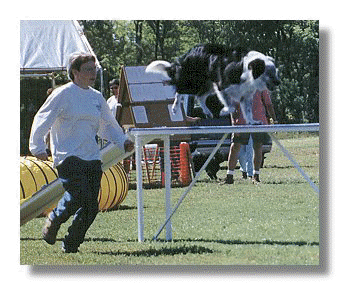
          
  
 
          
Photo
of the Moment
Newt found some of
his graphics at:
Pat's
Web Graphics
|

What
to do with a Smart Dog?

 |
How
do dogs get so smart? It has been said that the Border Collie is the world's
smartest breed of dog. I read that this assumption was based on the
opinion of over 200 obedience judges. |
Stanley Cohen,
author of The Intelligence of Dogs had those judges fill out a survey
from which he derived his "smart" list. Obviously, obedience is a biased
dog sport not necessarily based on the dog's natural abilities. It is far
better to evaluate a breed of dog according to the purpose for which they
were bred than a series of controlled exercises.
I've seen
many breeds perform just as well or even better in some instances doing
agility than Border Collies. I was at an agility trial a few years ago
where a Manchester Terrier took top honors, NOT a Border Collie. How could
that happen you ask?
Well,
Border Collies for all of their intellectual prowess sometimes tend to
do their own thing in the ring plus they also jump flat, consequently knocking
bars down. Both of those breed tendencies can cause lost points in
the ring. The little Manchester was quite willing to stay with his owner
and negotiated each jump with ease. So, even though Border Collie are said
to be the most intelligent breed of dog let's not discount his other four
paws friends for their own accomplishments.
Now if you do happen to have an
budding genius on your hands how do you entertain him? Here is a list taken
from the book Caninestein to help you curb his desire to take you
house apart piece by piece.
-
Getting and keeping a smart dog's attention
is probably the biggest hurdle the owner faces. To this end, make yourself
the most interesting thing in his environment. Praise in an excited, happy
voice. Happy dogs indicate their pleasure by wiggling. You should do the
same. Move about when you're happy with their performance. Act excited
when giving commands. Vary rewards from petting and praise to food. Vary
the types of treats you use. Make sure that nothing else around can compete
with how interesting and fun you are.
-
Because things usually come come so
easily to the brainiacs of the dog world, they can get frustrated when
something isn't working out for them. If the dog is stumped on an exercise,
he'll go into a canine hissy and be unable to concentrate. Stop and try
again another time.
-
Have several exercises and their sequence
in mind before beginning their training session. Once the bright dog understands
the first command, he'll want to move right to the next challenge. Challenges
are fun. Keep 'em coming. If you don't have something new to offer him
quickly, he'll lost interest.
-
Since this dog learns new commands
almost immediately, it's best to stop teaching an exercise once he's performing
it perfectly. If you ask him to repeat a behavior he already has down cold,
his Royal Boredness will elaborate on the exercise. "How about if I add
a pirouette to that jump?" the dog thinks, tired of the same old dull routine.
His creativity will end up confusing both of you.
-
Training sessions themselves can be
short: ten to twenty minutes, three or four times a week would be sufficient.
-
With a Caninestein, it is easy to try
to progress too far, too fast. The fact that he has accomplished a command
a few times does not signify that he really has it down in long term memory.
Teach one increment at a time. Practice them for a week at a time and then
proceed to the next step. If you have jumped too far and he becomes confused,
simply go back one or two steps and repeat them. Copyright (c) 1997 Fischer
& Delzio.
It can be tough to train a super smart
dog, but what you put into him you will definitely reap in rewards. Having
a dog that listens, behaves and may be even earns titles will cement the
bond between you. A far better thing than having him shipped off to the
dog shelter because you can't control him.
|
















